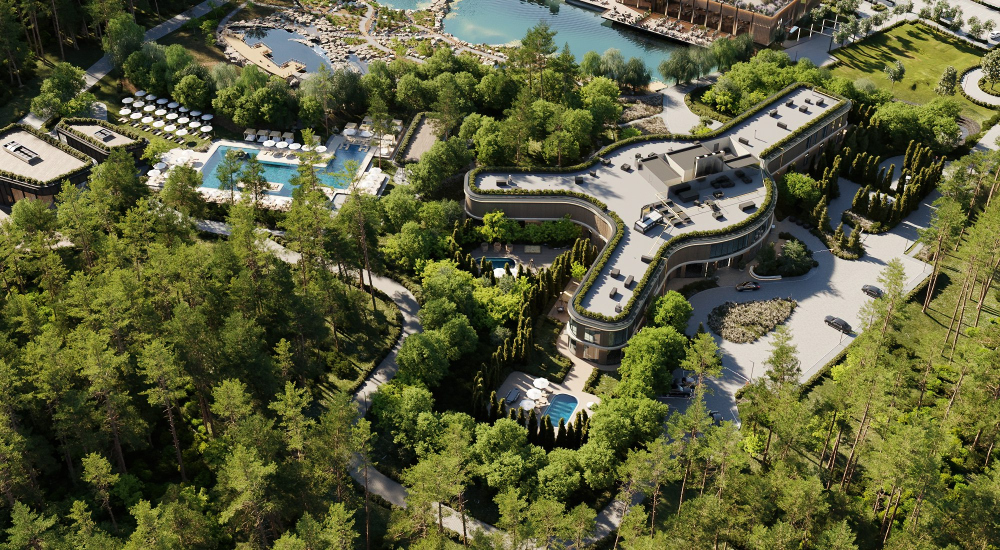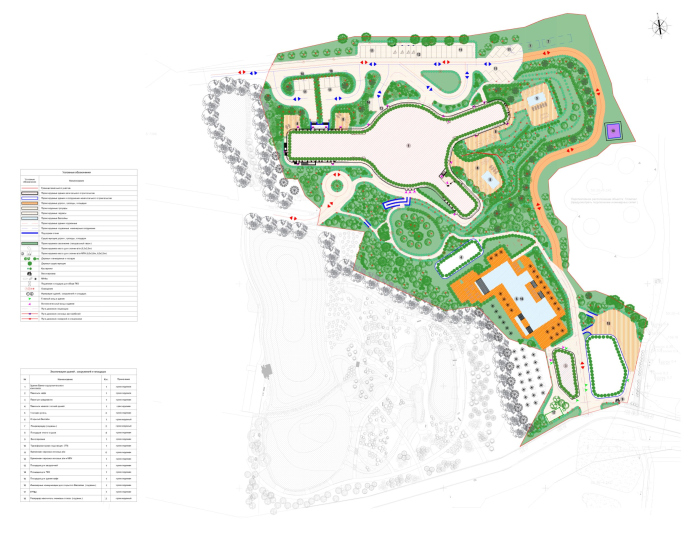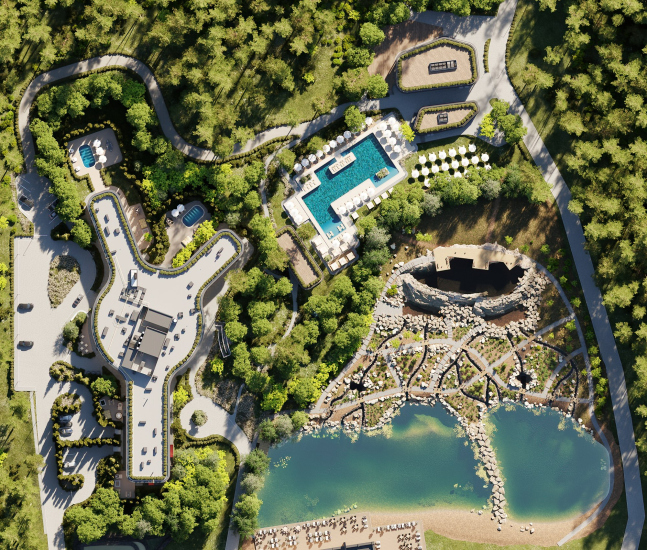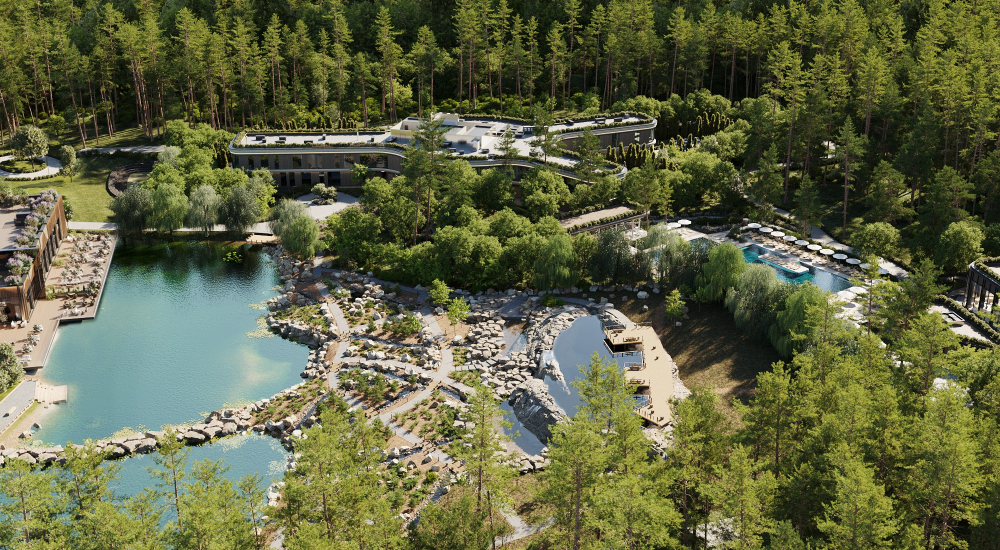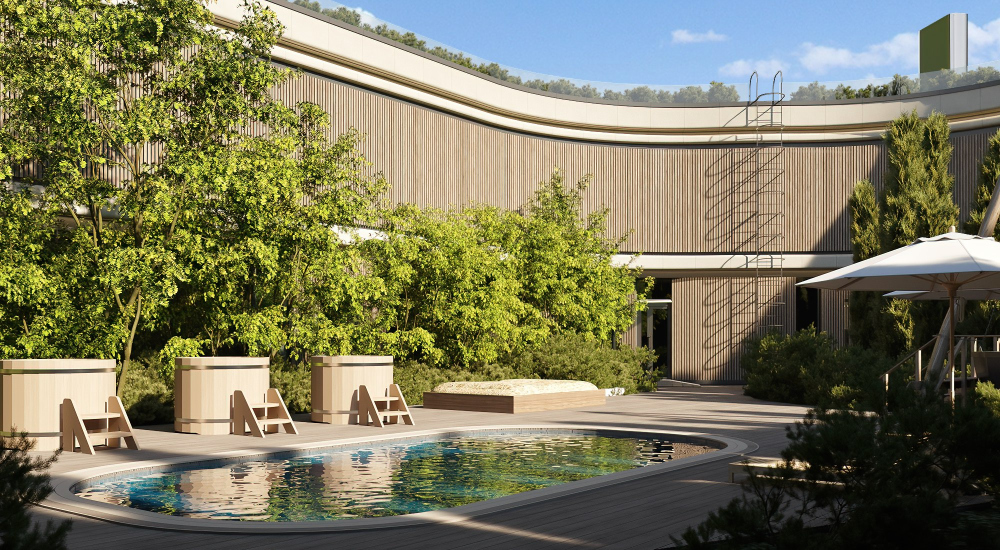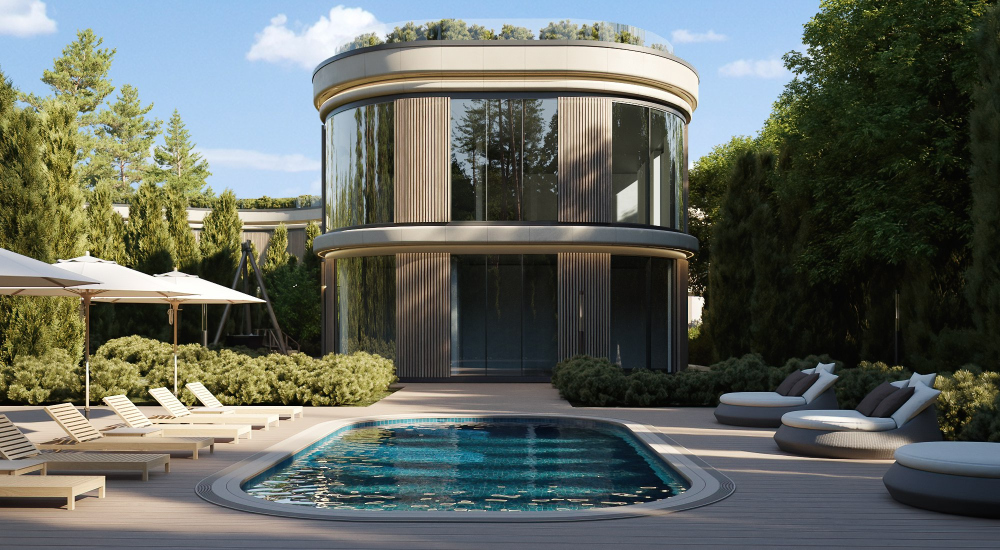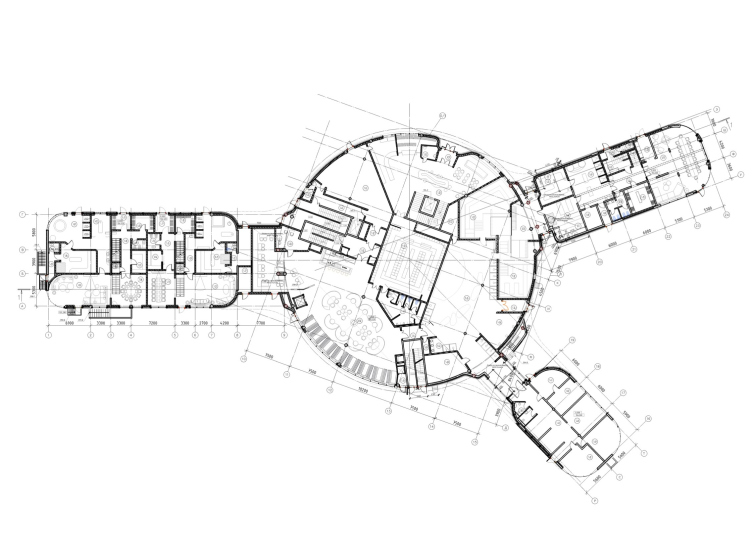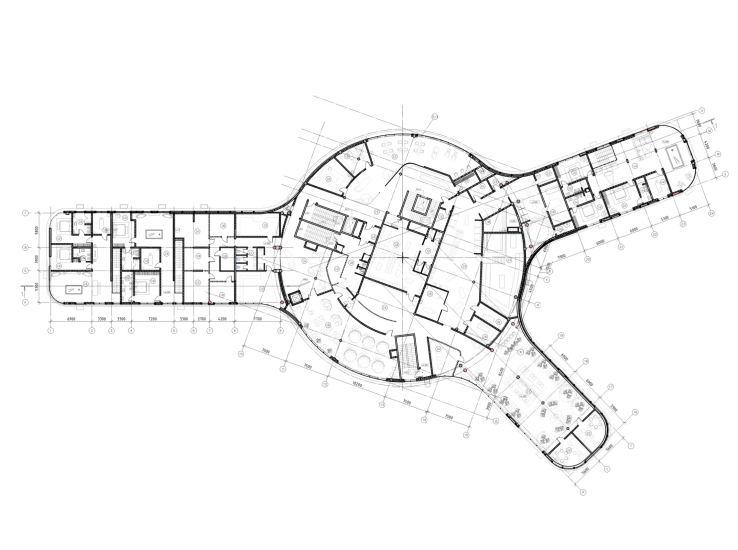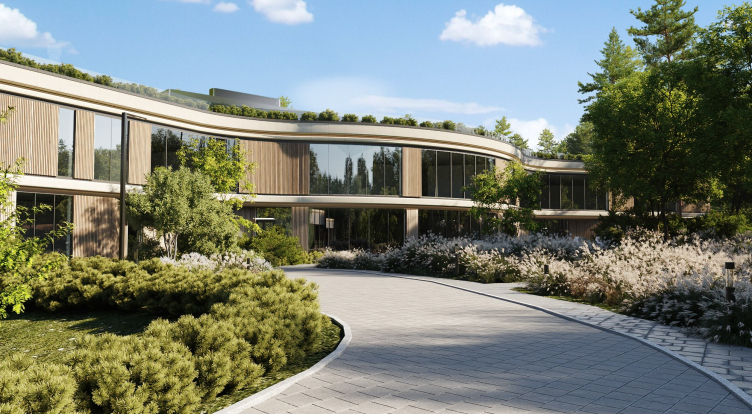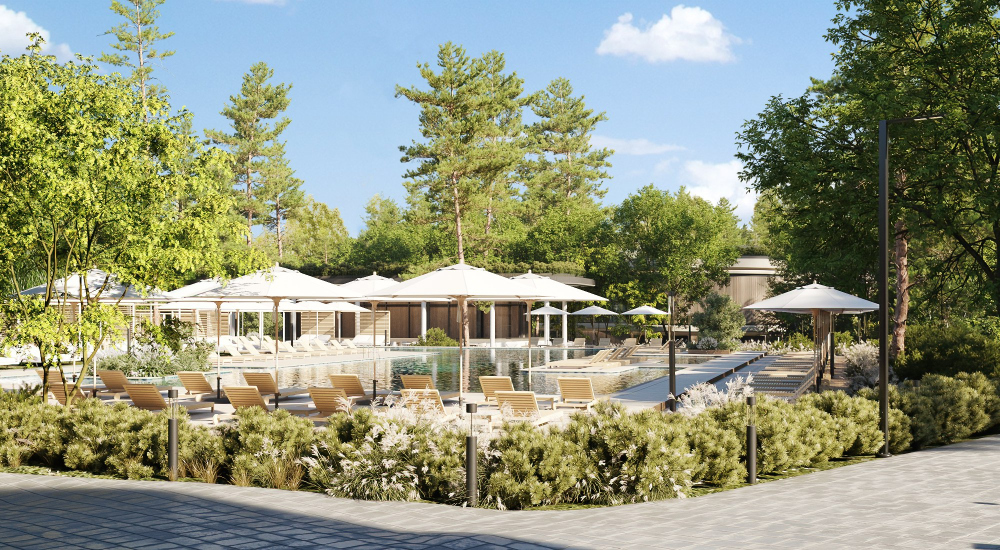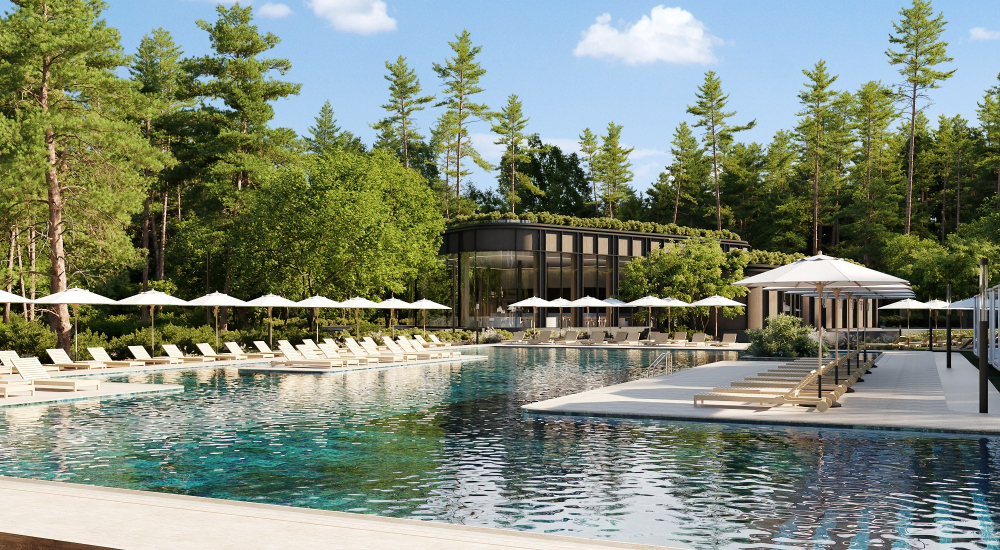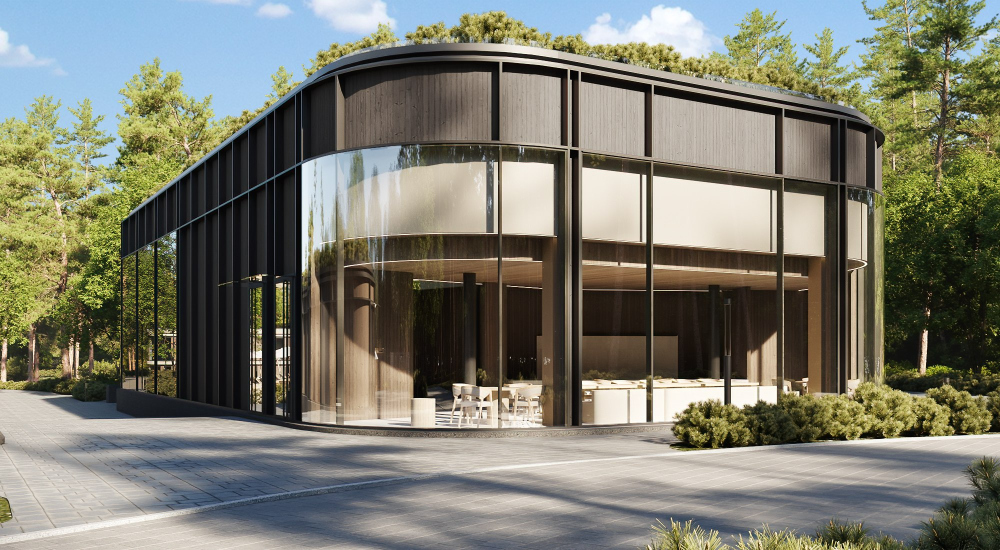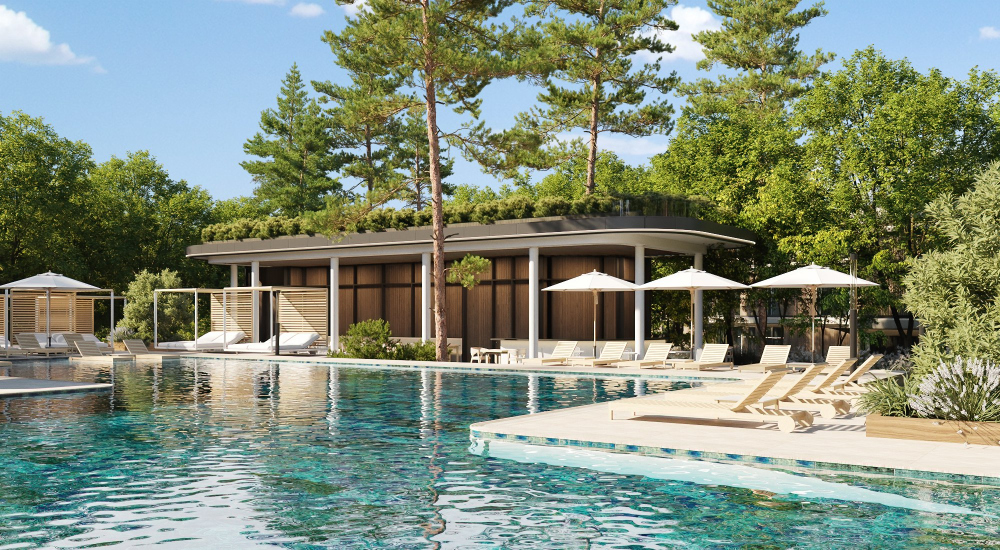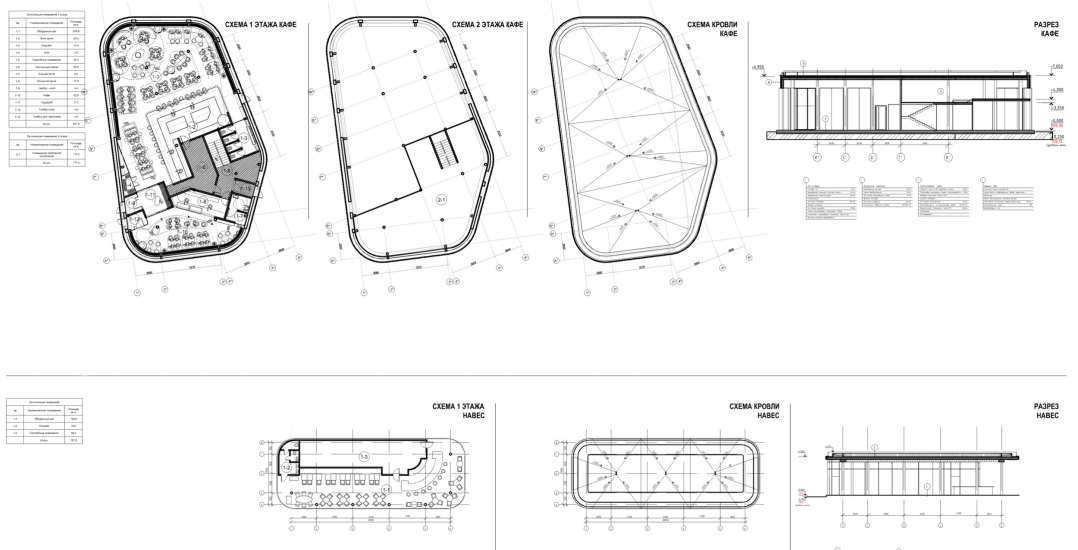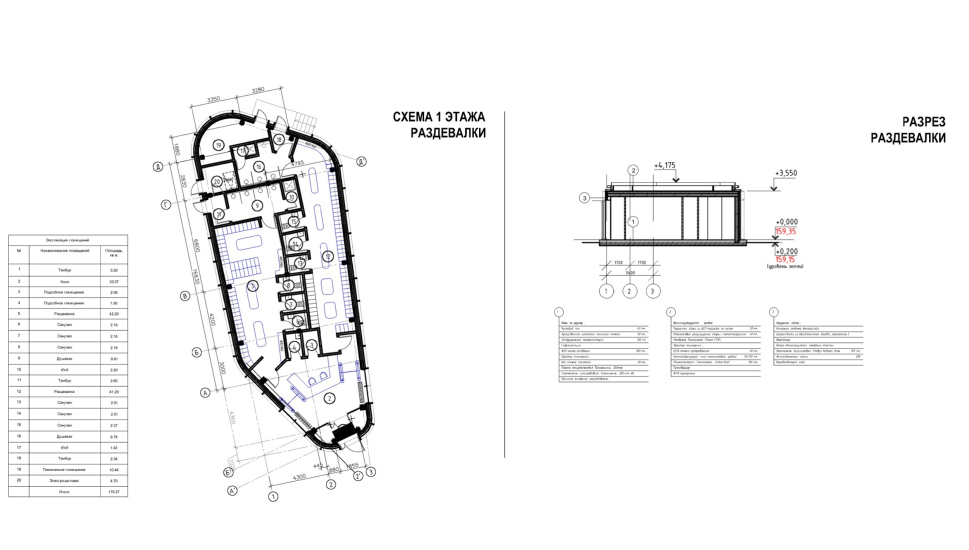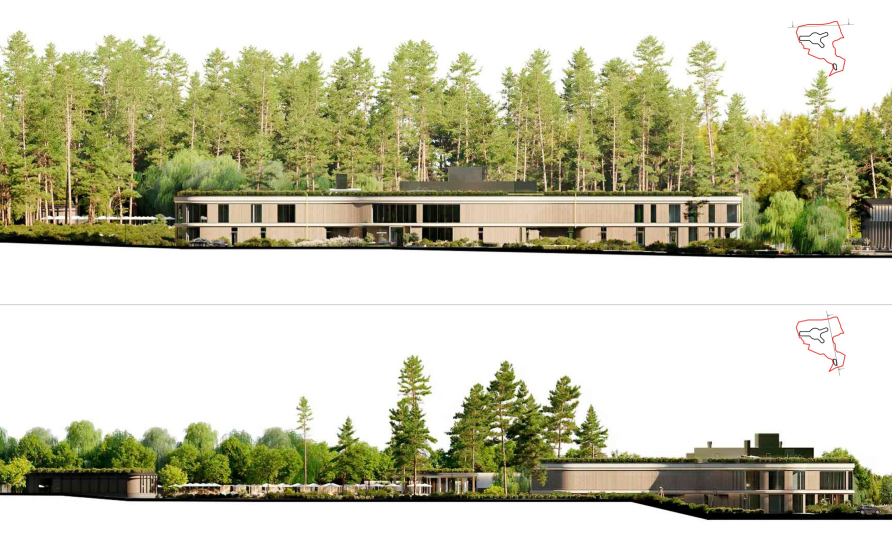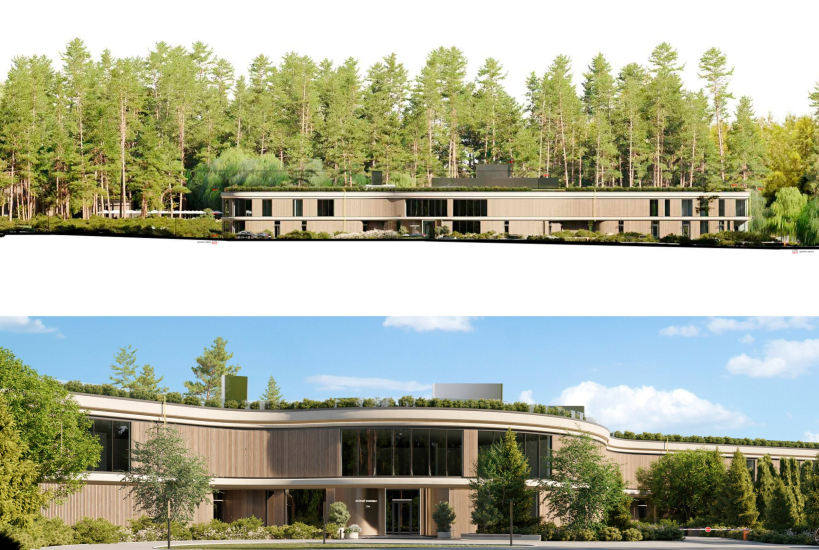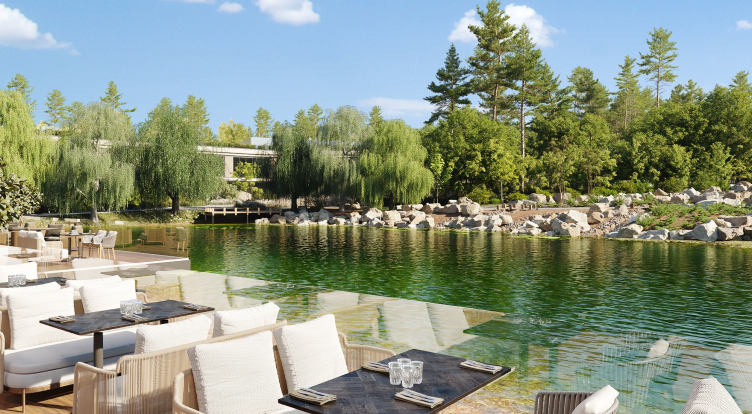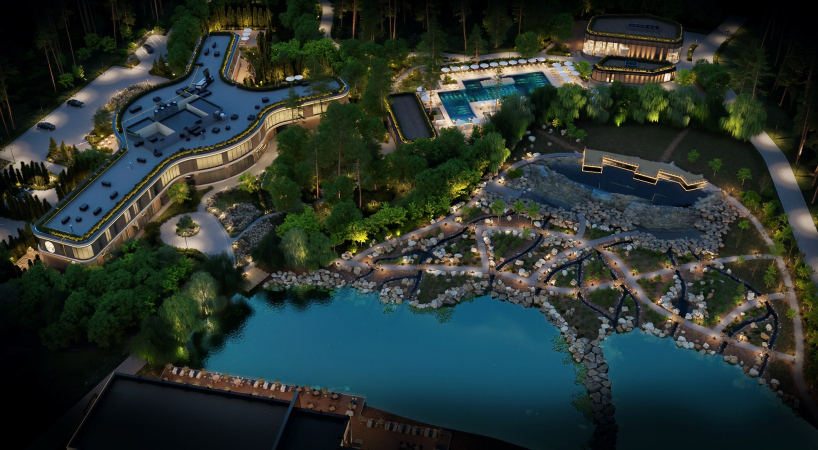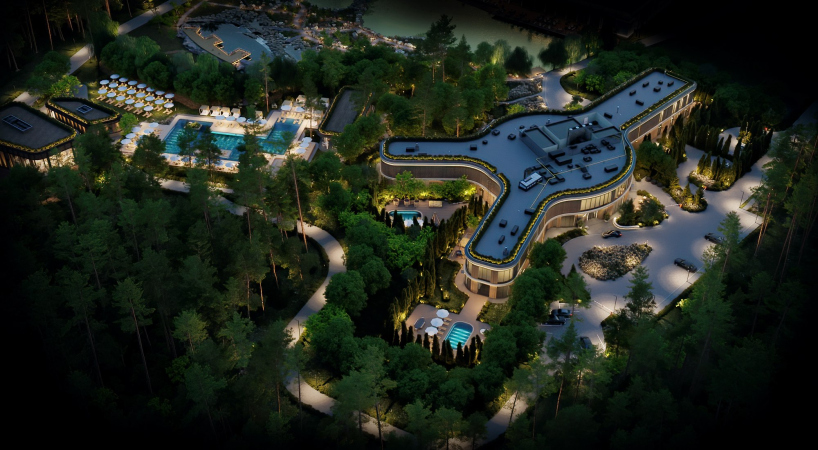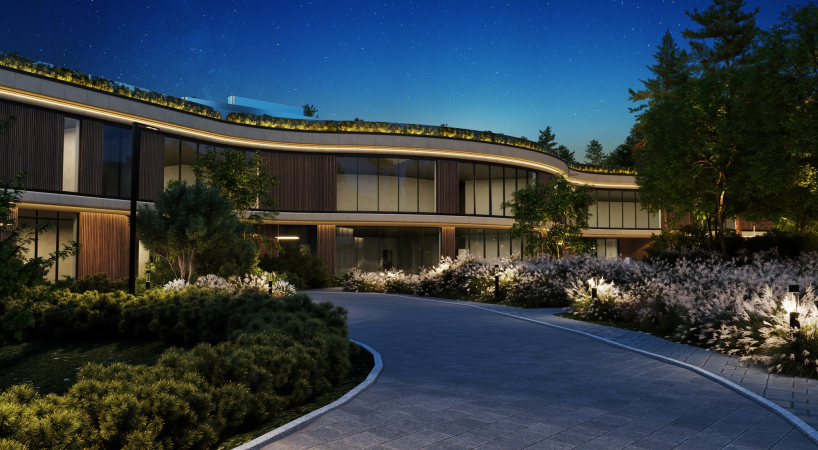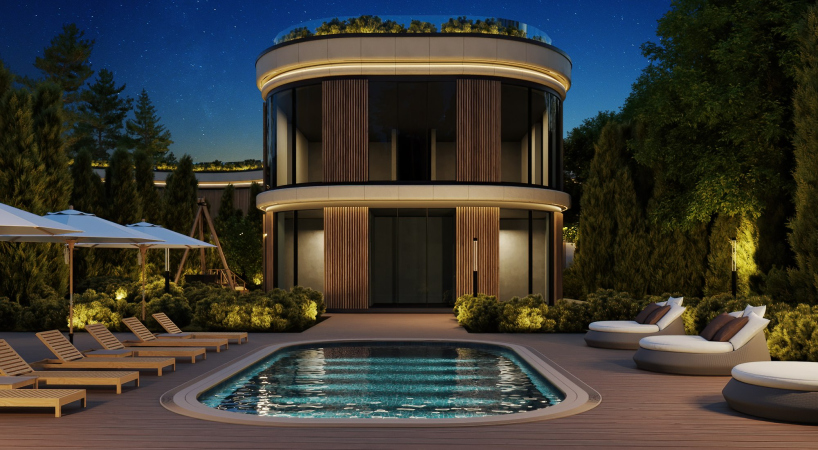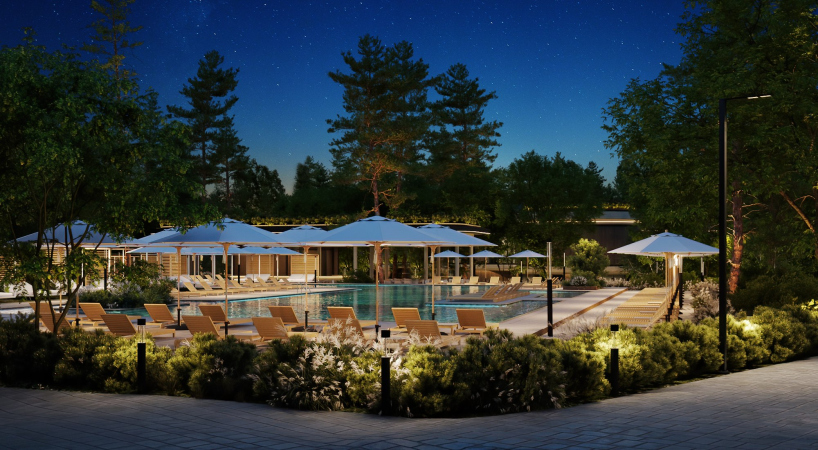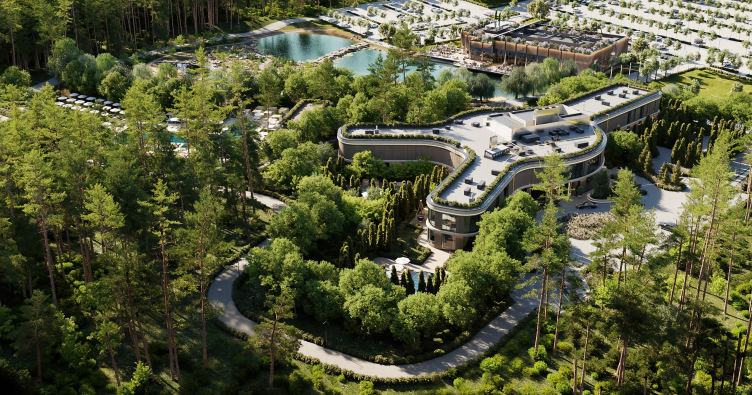Several years ago, part of the Romashkovsky forest was landscaped in a distinctly modernist manner. More recently, a pond with a gentle cascade of waterfalls was created at the park’s entrance. On the pond’s shore, a restaurant with a banquet hall is planned, with both architecture and interiors also designed by DBA-GROUP.
North of the pond, on a hill, the bathhouse complex is under construction – almost completed. In plan, it has a Y-shaped layout, reminiscent of a bird’s footprint, with a large cylindrical central section where all three “wings” converge.
The wings divide the bathhouse grounds into several courtyards and direct visitor flows, ensuring privacy, so that “even on the busiest days, guests will enjoy peace and tranquility”, as the complex’s promotional brochure promises. Also planned are “impressively sized hot tubs and relaxation swings”.
Thus, the task before the project’s authors, Vladislav Andreev and the architects of DBA-GROUP, was to design a modern bathhouse complex “with a full range of procedures”. As for the program, the client company, Malevich Bathhouse, has the floor.
Malevich Bathhouse press release
In the men’s section, there are two steam rooms accommodating 130 guests, finished in cedar and linden wood, with powerful red-brick stoves clad in Karelian pyroxenite, cold plunge pools, panoramic lounges with views of the forest and waterfall, a spacious restaurant with a fireplace, and a bath courtyard with a plunge pool, an outdoor lounge area, and a swing.
The women’s section – the largest in Russia so far – offers classic and herbal steam rooms with pyroxenite-clad stoves, just like in the men’s area, as well as hammams, a Charcot shower, spa treatment rooms, a beauty salon, and cozy relaxation areas overlooking the coniferous forest. For families and large groups, there are shared spaces featuring a modern Russian cuisine restaurant, a bar, a herbal steam room, and children’s zones with gentle steam. The VIP section comprises three two-story houses with private access, valet parking, terraces with plunge pools, and grill areas. Inside, guests will find individual steam rooms, hammams, massage rooms, spacious billiard rooms, bedrooms, and lounges with panoramic views, along with a 24-hour concierge service.
The women’s section – the largest in Russia so far – offers classic and herbal steam rooms with pyroxenite-clad stoves, just like in the men’s area, as well as hammams, a Charcot shower, spa treatment rooms, a beauty salon, and cozy relaxation areas overlooking the coniferous forest. For families and large groups, there are shared spaces featuring a modern Russian cuisine restaurant, a bar, a herbal steam room, and children’s zones with gentle steam. The VIP section comprises three two-story houses with private access, valet parking, terraces with plunge pools, and grill areas. Inside, guests will find individual steam rooms, hammams, massage rooms, spacious billiard rooms, bedrooms, and lounges with panoramic views, along with a 24-hour concierge service.
However, according to both architects and clients, the solution had to be executed in a contemporary style that would suit both the name and the overall character of the park. The clients supported the idea of reinterpreting the traditional image of the bathhouse.
In this case, the client and I were in complete agreement that the building in Malevich Park should not look like a typical bath complex. First, we needed architecture that was not ostentatious – without roots, ornamentation, or logs; and second, a layout different from the standard, made up of several separate structures placed throughout the site.
We also aimed to integrate the building as delicately as possible into its natural and recreational surroundings. We planned extensive landscaping, including large plants, positioned the courtyards with pools so they would not be visible from outside, and abandoned the initial idea of mirrored facades. Instead, we chose natural linden wood with fine milling to neutralize the recognizable grain pattern. The interiors we proposed are also modern and restrained, but with a generous use of natural materials. I think that to many clients, they will evoke a modern spa rather than a bathhouse.
We put a lot of work into the technical side – here I must give special thanks to our project technologists, Sergey Petrosyan and Sergey Bolshakov. Everything has been thought through and fine-tuned: utilities are concentrated on the lower level, partially recessed into the ground, making use of the slope, and the engineering systems are provided in full.
We also aimed to integrate the building as delicately as possible into its natural and recreational surroundings. We planned extensive landscaping, including large plants, positioned the courtyards with pools so they would not be visible from outside, and abandoned the initial idea of mirrored facades. Instead, we chose natural linden wood with fine milling to neutralize the recognizable grain pattern. The interiors we proposed are also modern and restrained, but with a generous use of natural materials. I think that to many clients, they will evoke a modern spa rather than a bathhouse.
We put a lot of work into the technical side – here I must give special thanks to our project technologists, Sergey Petrosyan and Sergey Bolshakov. Everything has been thought through and fine-tuned: utilities are concentrated on the lower level, partially recessed into the ground, making use of the slope, and the engineering systems are provided in full.
A special point in favor of – and a mark of respect for – the project’s authors is that, in seeking to avoid imagery dictated by tradition, they also refrained from going to the opposite extreme. There is neither an “architekton” nor some mega-brutalist multicolored cube “in memory of Malevich” here; instead, what has emerged is a calm, contemporary building. Absolutely every corner is rounded in the spirit of streamline, an impression reinforced by the glass-fiber-reinforced concrete bands of the floor slabs and the fine vertical rhythm of the wooden slats. From the outside, the facades form an endless wave, with alternating curves of varying radii flowing among greenery and pools.
This continuous, smooth wave effect is created by rounding all the corners along a generous arc. Yet the underlying plan is made up of very simple shapes: the central circle houses the shared halls, while the wings contain separate rooms. These are linked to the center by passageways; initially, the passageways were intended to be open, making the whole layout resemble a flying saucer on splayed legs. Later, however, the volume was increased and the passages enclosed.
The facades feature abundant glazing, which completely dispels any resemblance to a traditional bathhouse – a building that is, by definition, is naturally expected to be an enclosed one. The glass is bent to preserve the integrity of the form, enhancing the high-tech associations. The original idea had been to make the facades mirrored, like the sculptures of Grigory Orekhov or some of the park’s pavilions – that would have been pure high-tech – but the architects quickly abandoned this approach, opting instead for wood as a natural material.
Malevich Bathhouse and Wellness Complex
Copyright: © DBA-GROUP
The entrance is located at the southern corner of the site. Here, visitors are welcomed by two pavilions: a futuristic reception and a changing room adjacent to a large outdoor pool. This is the open, summer zone of the bathhouse complex.
The pavilions’ design is also built on rounding every corner, though their plans are asymmetrical – both individually and in their pairing. Bent glass and wood again play a major role in their facades: one pavilion is clad in black, while the other combines white supports, a large, sloping black roof, and wood in its natural tone.
Immersion in the natural context is a separate theme running through the entire project. The bathhouse complex is located close to the parking lot and to the well-known Razdory station. In working with the volume, the architects sought to “hide” it, so that people entering the park would not immediately identify the complex as a large building. Abundant landscaping is therefore planned all around; even on the roofs of the main building and the pavilions, the project envisions a row of planters, creating the effect of a furry edging – something between a collar and a hat. Contributing to this same effect – not quite full dematerialization, but a minimization of presence – are mirrored walls on the technical floors.
On the other hand, the architects also took care to ensure the privacy of the bath courtyards with their individual ponds: the wings are turned so that they are not visible from outside.
Malevich Bathhouse and Wellness Complex
Copyright: © DBA-GROUP
The interiors feature the same restrained beige tones, light natural wood, white tile, metal, countertops and benches of natural stone, and live greenery, with accents of gleaming metal. The circles of skylights in the relaxation hall echo the round lamps that imitate them in other spaces. Wooden and stone “slabs” set vertically catch the eye: more often they line the walls, adding a touch of ruggedness – especially the stone with its roughly split surface – and sometimes they even wrap around the shaft of a supporting column. In places, thin wooden planks “migrate” from the façade into the interior, alongside driftwood-like trunks and inserts reminiscent of large pebbles. These elements bring to mind dunes or taiga cliffs. Here and there an ornament appears – according to the client’s representatives, this pattern is part of the Malevich Baths’ brand identity. Nevertheless, it is clear that in designing the building, the architects prioritized restraint above all.
What impressed me most personally, however, were several open hearths with cylindrical exhaust flues above them. There seems to be one large one, for a group or for all visitors, and several smaller ones at individual tables for about four people each. You sit there, in a luxurious space, gazing at the fire – delicately enclosed in a glass ring for safety, yet still close enough to reach your hand toward. As they say, “within easy reach”.
All of this has been designed with a high degree of detail. The nighttime lighting has also been carefully considered.
Thus, from the outside – and in many respects inside as well – the bath complex resembles a modern spa. The most fitting name for it would probably be “thermae”. Although it resembles neither the putative Baths of Caracalla nor Peter Zumthor thermal baths, the building is rather conceived in the paradigm of a contemporary park pavilion: minimalist, yet with plastic ambitions – evident above all in the curve of the façade bands and the use of natural wood. A fairly large two-story volume with a total area of 9,528 square meters, the building is carefully and contextually hidden within perspectives and among the surrounding trees. Finally, its distinctive name – the Malevich Baths – which has absorbed, so to speak, both one of the supposedly “Russian” (in fact, not really) leisure traditions and a hint at the “Russian avant-garde”, is masked beneath the imagery of a park pavilion, of contemporary architecture as such. An interesting approach – and not a very common one.
Malevich Bathhouse and Wellness Complex
Copyright: © DBA-GROUP

